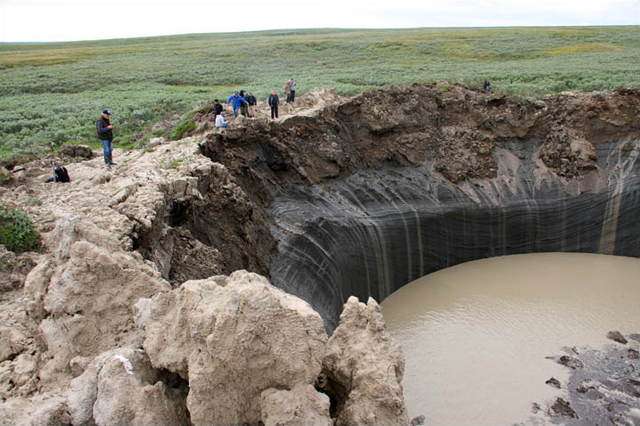If the predicted methane “pulse” comes to pass we will have a whole new climate ball-game.

A crater left by an exploding methane bubble in northwest Siberia. Photo Siberian Times
The name Siberia is said to derive from a Tartar phrase meaning “sleeping land”. That sleeping land is now waking up.
The mean temperature across the vast Siberian plains is around freezing point, and for much of the year rivers, lakes and the ground around them are frozen. But for the past 50 years the tundra’s surface temperature has steadily risen, with some startling results.
One highly-visible change in eastern Siberia is the Batagaika crater, a land slump about 85 metres deep and 1 km long. It is now expanding outward by 30 metres a year, releasing large volumes of methane, which as a greenhouse gas is many times more potent than carbon dioxide.
In northwest Siberia another warming phenomenon is exercising the minds of local and Moscow-based scientists: circular bulges in the tundra surface which move when people step on them. The experience has been called “trembling tundra”.
Scientists calculate there are 7000 such bulges across north-coastal Siberia, the Russian news agency Tass reported this month. When gas pressure below reaches a certain point the bulges can explode. Some of the more spectacular bangs have left a circular crater hundreds of metres across.
Methane explosions are a threat to communities and infrastructure. The Siberian Times newspaper reported last week that local authorities and scientists are trying to map developing bubbles to minimise potential damage. But the bigger danger is the methane released to the air above.
The bubbles are a result of recent record-breaking Arctic warmth, softening the ground over a huge expanse of northern Siberia and progressively releasing methane gas that has been held in the ground by permafrost for tens of thousands of years.
Recent analysis of the gas in bubbles on Bely Island, in the Arctic Ocean off the Yamal Peninsula, found methane concentrations to be 1000 times higher than in the surface air.
In the North American Arctic, methane is escaping from wide expanses of land once considered permanently frozen, now turned into impassable bogs.
Latest global emissions data reported in the annual World Meteorological Organization climate report released last week show atmospheric methane increasing 44 per cent faster than carbon dioxide. It is now more than 2.5 times its pre-industrial level.
From the Batagaika crater, Bely Island bubbles, North American bogs, and countless other locations around the Arctic rim, land-based methane is being released at a rate unknown in all of human existence. But a bigger methane shock is in store, from ocean waters just to the north.
The Arctic is warming at twice the global average, America’s National Oceanic and Atmospheric Administration (NOAA) reports. This northern winter has seen record low ice cover.
Science has long warned that global climate would be massively threatened if a warming Arctic Ocean released solid methane trapped in huge quantities in frozen sediment. The Arctic Ocean is warmer now than it’s been for tens of thousands of years.
Just this month, NOAA satellite data showed a strong rise in methane levels over a broad area above the shallow waters of the East Siberian continental shelf, indicating that melting of this solid methane (methane clathrate) is already under way.
A 2010 Russian research paper warned of a significant risk that within years as much as 50 billion tonnes of methane could be released in a single large pulse from East Siberian waters. That much methane would cause an immediate global temperature rise of 0.6C, pushing post-industrial warming past the “safe” limit of 1.5C acknowledged in the Paris Agreement of 2015.
Science remains divided on the plausibility of this scenario, but it has attracted support from established Arctic specialists outside Russia, including Cambridge (UK) ocean physicist Peter Wadhams.
Our failure to curb carbon dioxide emissions has already left us in deep trouble. It’s hard to imagine where we’ll be if the projected methane spike comes to pass.
A decade ago cutting emissions was the only realistic policy option, and the desperate, vastly more expensive last resort of removing carbon dioxide from the air never got a look in. Now it’s back on the table.
